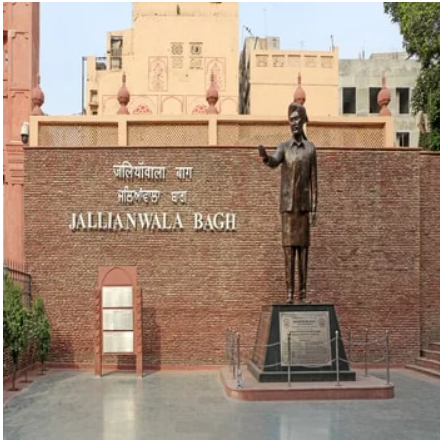~ B. Sujitha
Jallianwala Bagh is located in Amritsar, Punjab. The word ‘Bagh’ means Garden. Jallianwala Bagh has gained historical significance. It stands as a memory of the tragic incident ; also as a strong memory of the Indian Independence struggle. Jallianwala_Bagh_massacre is also called the Massacre of Amritsar.
The Events in the run-up to the Incident:
Britain was involved in World war 1 (1914-1918). During this period, the British enacted a series of legislations in India. These legislations have armed Britishers with repressive and emergency powers. British Government also passed the Rowlatt_Act, which gave the British government in India unregulated powers to arrest Indians. The Montague- Chelmsford reforms of 1919 also disappointed Indians as they were not contiguous with the promises made by the Britishers. These promises were made to secure the support of Indians for Britishers in World War 1.
The acts and the reforms triggered widespread discontentment among Indians, especially in Punjab. In fact, the arrest of two freedom struggle leaders, Saifuddin Kitchlew and Satyapal, acted as an immediate trigger in Punjab.
The Fateful Day:
The Brigadier-General Reginald Dyer had issued notices banning all the meetings in Punjab. He expected an insurrection by the people.
On the 13th of April 1919, people from in and around Amritsar gathered in the Jallianwala Bagh. This gathering was called on the day of Hindu and Sikh festival of Vaisakhi. The gathering intended to peacefully protest the arrest and deportation of two national leaders Satyapal and Saifuddin Kitchlew. General Dyer along with his battalion entered into the Jallianwala Bagh through the only narrow entrance. The entrance was blocked by police personnel who opened fire on the unarmed crowd. He did not give a prior warning before opening the fire. His troops fired for about 10 minutes.
People who gathered had no way to escape out. The crowd ran amok. People tried to save their lives by climbing walls, jumping into the well etc. yet hundreds of people died. According to an official report by Sewa Samiti, around 379 people were killed and more than 1,200 were injured. The following day General Dyer mentioned in a report that “I have heard that between 200 and 300 of the crowd were killed. My party fired 1,650 rounds”.
The Aftermath of the incident:
After the incident, Martial_law was proclaimed in Punjab. Outrage among Indians grew on hearing about the incident. Nobel Laureate Rabindranath Tagore gave up the Knighthood he received in 1915. The Moderate section of the Indian National Congress had shed their loyalty towards Britishers. This horrific massacre became one of the reasons behind the Non-cooperation_movement launched in 1920 by Gandhiji.
Hunter Commission and the lost trail:
The Government of India appointed Hunter_Commission. This commission was tasked with the responsibility of inquiring into the excesses committed by General Dyer. The commission only criticised General Dyer for his actions. It did not impose any penal actions and disciplinary actions on Dyer. On the other hand, Dyer’s actions were condoned by his superiors. The only punishment that General Dyer received was removal from his position and a ban on further employment. Clearly, punishment given to General Dyer did not match the horrific actions he did.
The Memorial:
To commemorate the sacrifices and the contributions, Jallianwala Bagh turned into a Memorial Park. The Jallianwala Bagh National Memorial Act was passed in 1951. The act provides for the erection of a National Monument in Jallianwala Bagh. The act also created a Trust to manage the National Memorial.
The bullet holes on the walls are preserved. A plaque has been attached there describing the incident.

The Martyrs well is surrounded by Martyrs Memorial. The memorial has 120 written on it. 120 is the number of bodies that were recovered from the well.

Martyrs gallery and museum was established. It contains paintings of the inside of Jallianwala Bagh and the incident. Paintings of political leaders are also displayed. Newspaper clippings of the incident are also preserved there.

At Present :
Jallianwala Bagh stands as a stark memory of India’s freedom struggle and the lives lost in that struggle. With the work of successive governments in India, the site has turned into a tourist spot. It is carefully tended to commemorate our National struggle for Independence.
Must Read : https://skchildrenfoundation.org/elections-and-democracy/





